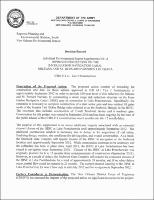Please use this identifier to cite or link to this item:
https://hdl.handle.net/11681/36073Full metadata record
| DC Field | Value | Language |
|---|---|---|
| dc.contributor.author | United States. Army. Corps of Engineers. New Orleans District | - |
| dc.date.accessioned | 2020-04-08T14:30:10Z | - |
| dc.date.available | 2020-04-08T14:30:10Z | - |
| dc.date.issued | 2012-05 | - |
| dc.identifier.uri | https://hdl.handle.net/11681/36073 | - |
| dc.description | Individual Environmental Report Supplemental | - |
| dc.description.abstract | The project approved in IER #11 Tier 2 Pontchartrain consists of constructing one sector and two non-navigable vertical lift gates in the Inner Harbor Navigation Canal 540 feet south of the Senator Ted Hickey Bridge (also known as Seabrook Bridge) and the Bascule Railroad Bridge with floodwall tie-ins to LPV 104 to the west and LPV 105 to the east. While officially the IHNC is a navigation channel, the use of the term “IHNC” for the purposes of this document include all of the waters and shoreline bounded on the east where the Mississippi River Gulf Outlet navigation channel and the Gulf Intracoastal Waterway diverge; to the south at the IHNC lock complex; and the north at the point where the IHNC intersects with Lake Pontchartrain. The term “100-year level of risk reduction,” as it is used throughout this document, refers to a level of risk reduction which reduces the risk of hurricane surge and wave-driven flooding that the New Orleans Metropolitan Area has a 1 percent chance of experiencing each year. The Preconstruction Services for the Seabrook Gate Complex Early Contractor Involvement contract was awarded October 30, 2009, and the construction option was exercised in July 2010, however, actual construction did not start until September 2010. The planned construction was originally estimated to last 36 months with a channel closure on the IHNC for approximately 6 to 12 months. In addition to the delay in the construction start, there were also delays associated with the acquisition of real estate, finalizing design, weather, subsurface site conditions for driving piles, and actual construction. As a result, of these delays, it is proposed that for continued construction on the Seabrook Gate Complex, the IHNC would be closed to navigation at the Seabrook location until approximately September 2012. The IHNC closure duration is currently 6 months into the required additional 12 month closure. This NEPA document is being prepared concurrent with the requested proposed action and provides an evaluation of the potential impacts associated with the proposed closure of the IHNC to navigation for an additional 12 months to complete construction of the Seabrook Gate Complex. | en_US |
| dc.description.sponsorship | United States. Army. Corps of Engineers. | en_US |
| dc.description.tableofcontents | 1.0 INTRODUCTION.......................................................................................................................... 1 1.1 BACKGROUND ............................................................................................................... 2 1.2 PURPOSE AND NEED FOR THE PROPOSED ACTION .......................................... 3 1.3 AUTHORITY FOR THE PROPOSED ACTION ......................................................... 3 1.4 PRIOR REPORTS ............................................................................................................ 4 1.5 PUBLIC CONCERNS ...................................................................................................... 5 2.0 PROPOSED ACTION AND ALTERNATIVES ......................................................................... 6 2.1 ALTERNATIVES DEVELOPMENT AND PRELIMINARY SCREENING CRITERIA ........................................................................................................................ 6 2.2 DESCRIPTION OF THE ALTERNATIVES ................................................................ 6 2.3 PROPOSED ACTION ...................................................................................................... 6 2.4 NO ACTION ..................................................................................................................... 9 2.5 ALTERNATIVES ELIMINATED FROM FURTHER CONSIDERATION ............. 9 3.0 AFFECTED ENVIRONMENT .................................................................................................. 10 3.1 ENVIRONMENTAL SETTING ................................................................................... 10 3.2 SIGNIFICANT RESOURCES ...................................................................................... 10 3.2.1 Hydrology ............................................................................................................ 11 3.2.2 Water Quality ....................................................................................................... 18 3.2.3 Aquatic Resources and Fisheries ......................................................................... 27 3.2.4 Essential Fish Habitat .......................................................................................... 30 3.2.5 Threatened and Endangered Species ................................................................... 33 3.2.6 Recreational Resources ........................................................................................ 37 3.2.7 Transportation and Navigation ............................................................................ 39 3.3 SOCIOECONOMIC RESOURCES ............................................................................. 42 4.0 CUMULATIVE IMPACTS ........................................................................................................ 50 5.0 SELECTION RATIONALE ....................................................................................................... 51 6.0 COORDINATION AND CONSULTATION ............................................................................ 52 6.1 AGENCY COORDINATION ........................................................................................ 52 7.0 MITIGATION .............................................................................................................................. 54 8.0 COMPLIANCE WITH ENVIRONMENTAL LAWS AND .................................................... 54 REGULATIONS ....................................................................................................................................... 54 9.0 CONCLUSIONS .......................................................................................................................... 54 9.1 FINAL DECISION ......................................................................................................... 54 9.2 PREPARED BY .............................................................................................................. 56 9.3 LITERATURE CITED .................................................................................................. 57 Appendix A: List of Abbreviations and Acronyms Appendix B: Modeling Reports Appendix C: Public Comment and Responses Appendix D: Members of Interagency Environmental Team Appendix E: Interagency Correspondence Appendix F: Public Meeting Minutes | - |
| dc.format.extent | 91 pages / 6.11 MB | - |
| dc.format.medium | PDF/A | - |
| dc.language.iso | en_US | en_US |
| dc.publisher | United States. Army. Corps of Engineers. New Orleans District. | en_US |
| dc.rights | Approved for Public Release; Distribution is Unlimited | - |
| dc.source | This Digital Resource was created in Microsoft Word and Adobe Acrobat | - |
| dc.subject | Pontchartrain, Lake (La.) | en_US |
| dc.subject | Flood control | en_US |
| dc.subject | Hurricanes | en_US |
| dc.subject | Environmental management | en_US |
| dc.subject | Inner Harbor Navigation Canal (La.) | en_US |
| dc.title | Final Individual Environmental Report Supplemental, Improved Protection on the Inner Harbor Navigation Canal, Orleans and St. Bernard Parishes, IERS #11.d - Tier 2 Pontchartrain | en_US |
| dc.type | Report | en_US |
| Appears in Collections: | Environmental Documents | |
Files in This Item:
| File | Description | Size | Format | |
|---|---|---|---|---|
| IERS 11.d Tier 2 Pontchartrain Final Document.pdf | 6.11 MB | Adobe PDF |  View/Open |